Bees are pretty incredible creatures, and about 80% of flowering plants, including food crops like melons, are pollinated by honeybees. Despite their tiny size, the average bee can travel up to 5 miles in search of food too. And, of course, bees also make that sweet, sweet honey we all love!
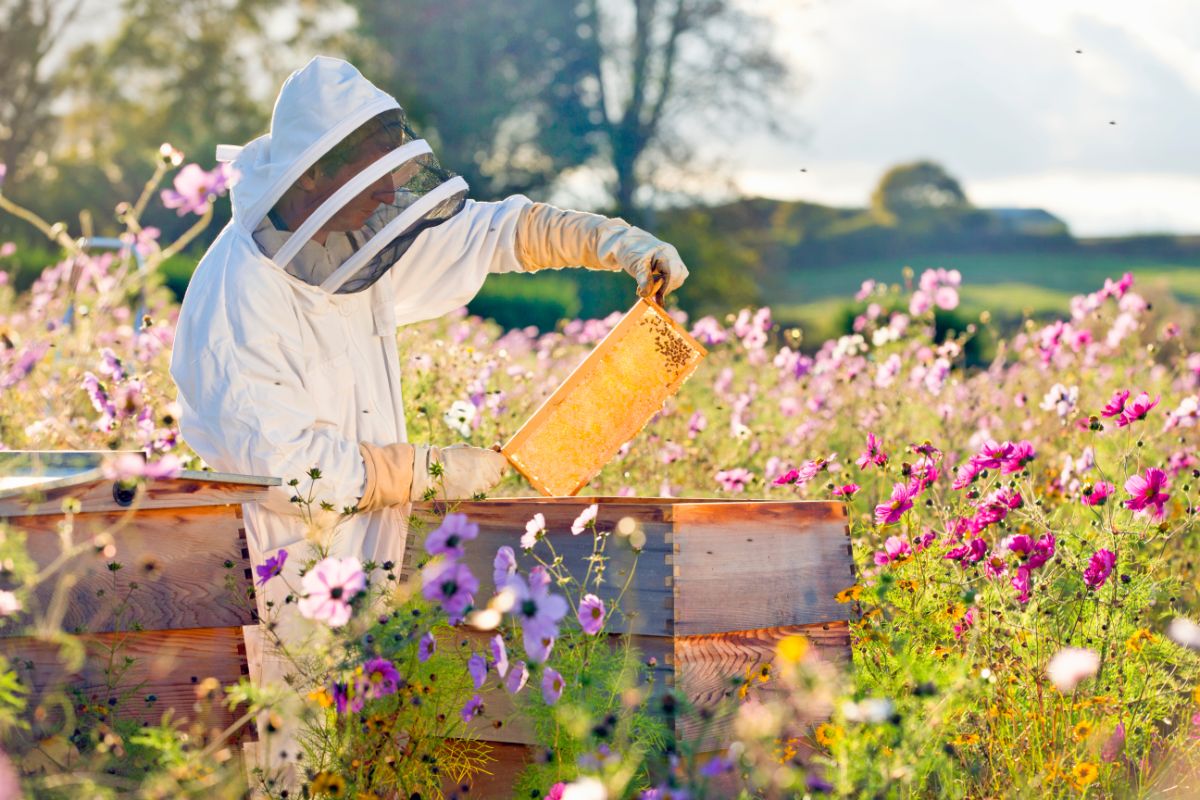
If you have been enchanted by the magic of bees and decided to keep your own beehives, you may not need to grow any special plants for your bees because they are just so good at foraging for wildflowers. But if you’d like to boost the output of your hives and harvest the tastiest honey around, you may want to plant some of the flowering plants in the list below. Honeybees will appreciate the rich nectar and pollen in these blooms, and you’ll enjoy their attractive flowers too!
Jump to:
- 18 best plants to grow near beehives
- 1. Anise hyssop (Agastache foeniculum)
- 2. Milkweed (Asclepias spp.)
- 3. Sunflowers (Helianthus spp.)
- 4. Russian sage (Salvia yangii)
- 5. Bee balm (Monarda spp.)
- 6. Asters (Aster spp.)
- 7. Liatris (Liatris spicata)
- 8. Coriander (Coriandrum sativum)
- 9. Cover crops
- 10. Dandelions (Taraxacum officinale)
- 11. Cosmos (Cosmos spp.)
- 12. Mint (Lamiaceae spp.)
- 13. Goldenrod (Solidago spp.)
- 14. Coneflower (Echinacea spp.)
- 15. White Dutch clover (Trifolium repens)
- 16. Berries
- 17. Fruit trees
- 18. Cucurbits
- Summary
18 best plants to grow near beehives
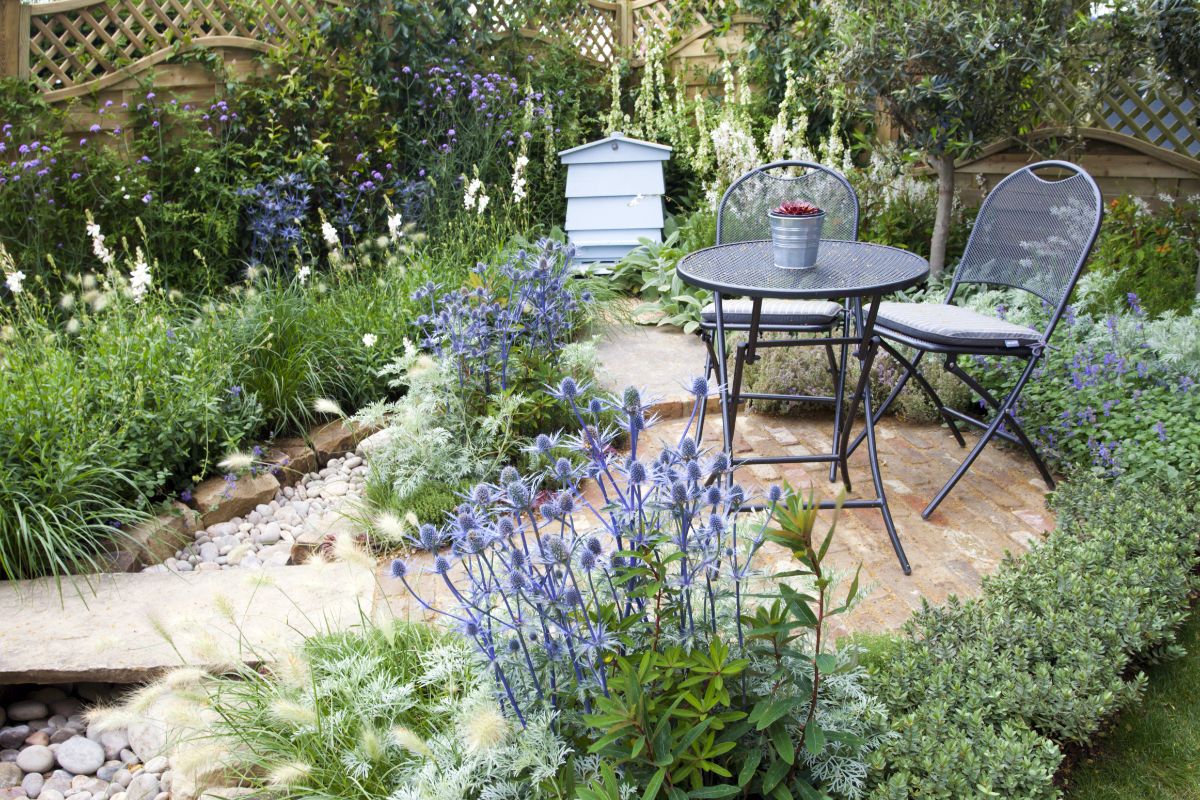
Plants with lots of pollen and nectar and wide open flower faces are the easiest plants for bees to forage from. Wildflowers and native plants are also great choices for bees, and they will be equally supportive of honeybee and native wild bee populations. While there are other plants that you can grow near beehives, below are some of the best choices to boost your hive’s production of luscious and flavorful honey.
1. Anise hyssop (Agastache foeniculum)

| Plant name: | Anise hyssop |
| Light requirements: | Full sun to part shade |
| Water requirements: | Moderate to low |
| Growing zone: | Zones 3 to 8 |
| Bloom time: | Summer to fall |
Anise hyssop is a fragrant, flowering plant in the mint family, and, like other mints, it can spread vigorously via underground rhizomes. As this plant matures, it forms an attractive mounding growth habit that can be used to fill in ornamental beds; however, anise hyssop is pretty enough to grow on its own too. When in bloom, anise hyssop produces tall spikes of purple flowers that pair beautifully with coneflower, yarrow, and other bee favorites.
While anise hyssop is often grown as an ornamental, it is also edible, and flowers make a lovely addition to salads and teas. As its name suggests, anise hyssop has a licorice-like flavor, which may be an acquired taste for some, but it is delightful if you like star anise and other similar herbs. Technically a short-lived perennial, anise hyssop plants may die back after 3 years, but these plants are good at self-seeding, so you rarely need to replant them.
2. Milkweed (Asclepias spp.)
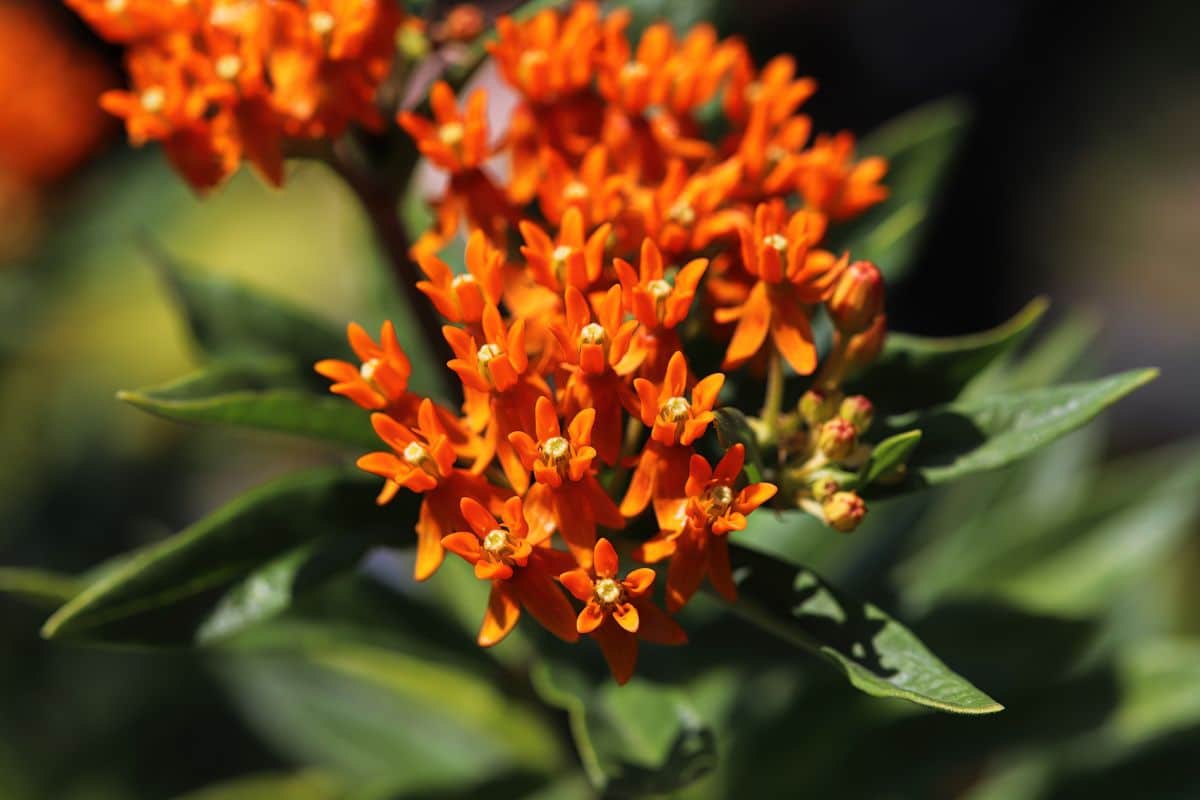
| Plant name: | Milkweed |
| Light requirements: | Full sun |
| Water requirements: | Depends on variety |
| Growing zone: | Zones 3 to 9 |
| Bloom time: | Late spring to fall |
Milkweed is famous for being a top pollinator plant, and it’s closely linked to monarch butterflies. After all, milkweed is the host plant for monarch caterpillars, which will only feed on milkweed leaves as they’re developing! However, milkweed is a very useful plant, and it will offer benefits to bees when it's grown near hives.
Milkweed plants are often quite fragrant, and they’re rich in the nectar, and pollen bees need. But milkweed are also very pretty plants that can hold their own in ornamental beds, and their colorful flowers may make them your favorite plant yet. You can find a wide variety of milkweeds to grow, including plants with colorful orange or purple flowers and other cultivars that can tolerate very wet or dry garden beds.
3. Sunflowers (Helianthus spp.)
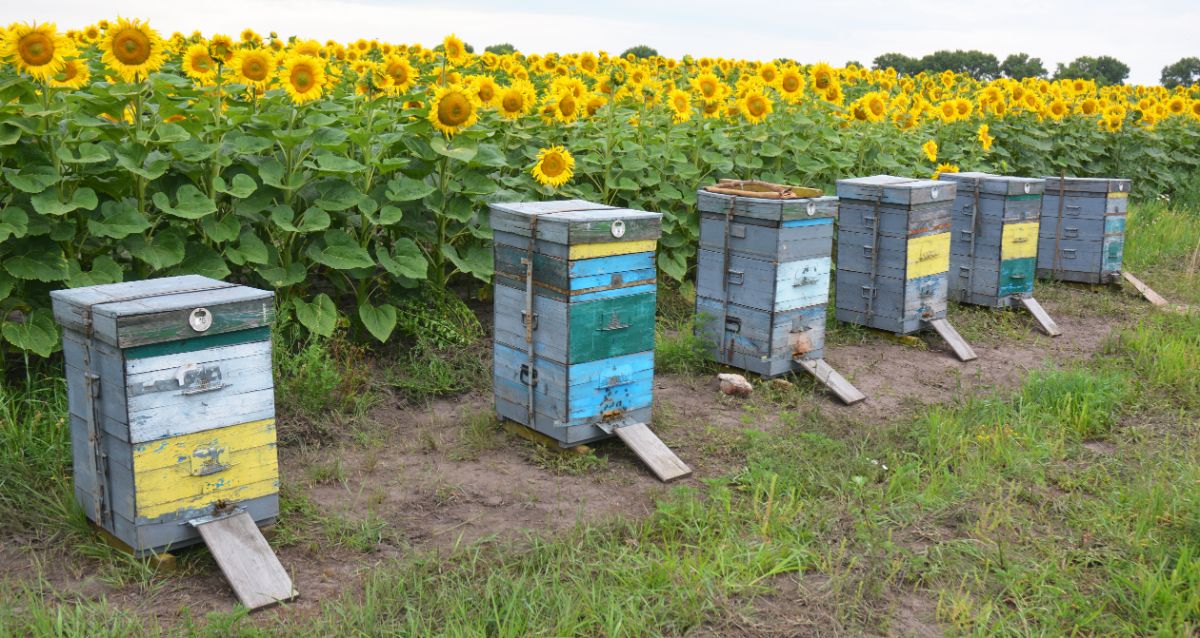
| Plant name: | Sunflowers |
| Light requirements: | Full sun |
| Water requirements: | Moderate |
| Growing zone: | Zones 4 to 9 |
| Bloom time: | Summer to fall |
Cheery sunflowers are always a joy to keep, but their large flower heads and abundance of nectar and pollen make them a favorite among bees too. Tall sunflowers, like ‘Mammoth’ sunflowers, are often grown in vegetable gardens, but they can readily adapt to flower gardens as well. You can also find smaller, dwarf sunflower varieties that can be kept in pots if you’re only working with a small gardening space.
Most often, you’ll find sunflowers with buttery, yellow petals, but you can also pick up seeds for uniquely colored sunflower varieties. Today, you can find sunflowers with dark maroon flowers or brilliant white blooms. Even better, after they’ve been pollinated by your bees, sunflowers will produce lots of edible seeds, which you and wild birds can snack on!
4. Russian sage (Salvia yangii)
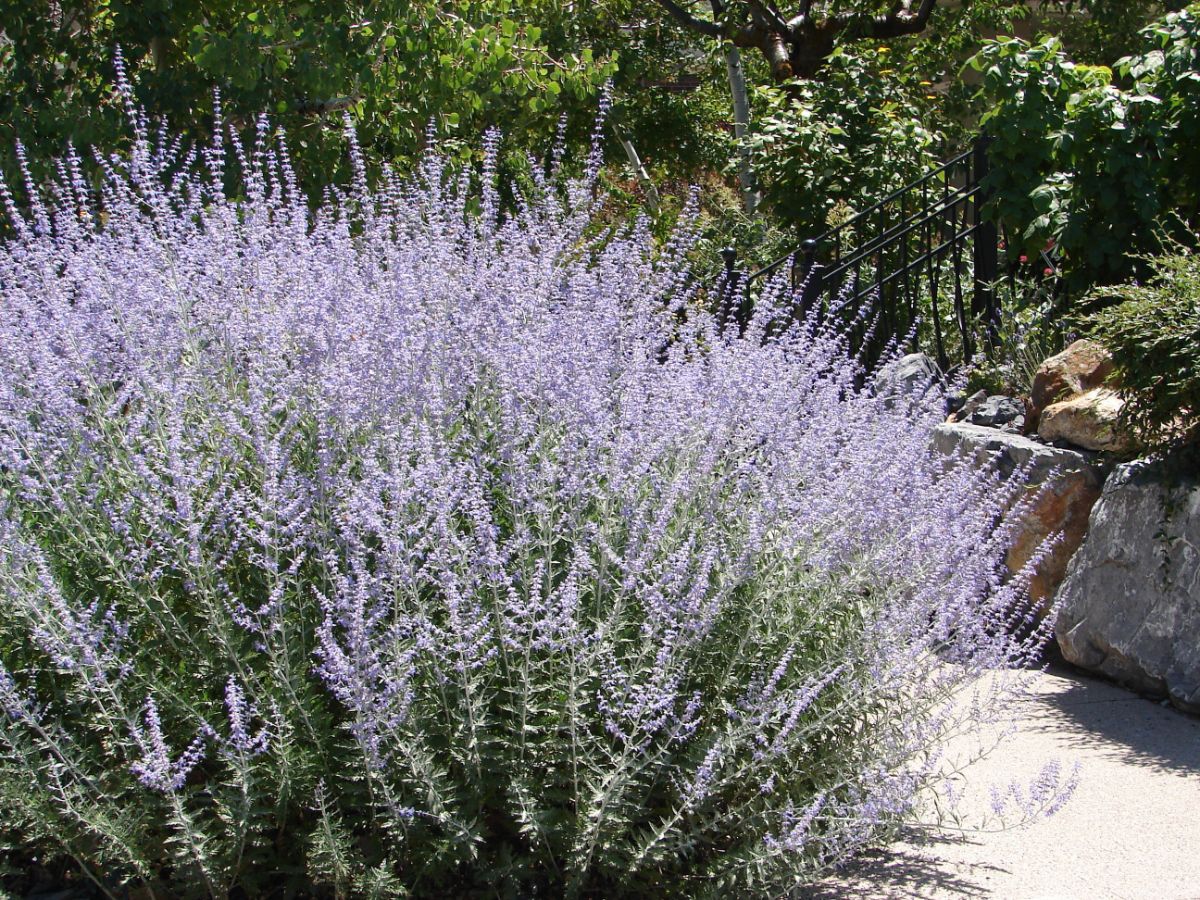
| Plant name: | Russian sage |
| Light requirements: | Full sun |
| Water requirements: | Moderate to low |
| Growing zone: | Zones 4 to 9 |
| Bloom time: | Mid-summer to fall |
Russian sage looks a bit like anise hyssop, but it is taller, and it has a more airy growth habit. Full-grown Russian sage plants can grow between 3 and 5’ tall, and they can spread about 2 to 4’ in width. In gardens, Russian sage is usually grown towards the rear or north side of beds to keep it from blocking light from reaching shorter plants, but Russian sage is also striking enough to be grown on its own in an empty patch of your yard.
Blooming from summer to fall, Russian sage is mostly known for its tall spires of purplish-blue flowers, but its leaves are equally attractive and have a fine, silvery green color. Bees will often flock to Russian sage in droves, but garden visitors will also appreciate this plant’s rich fragrance. Russian sage has a heady aroma with notes of sage and lavender that smells truly divine on a summer breeze!
5. Bee balm (Monarda spp.)
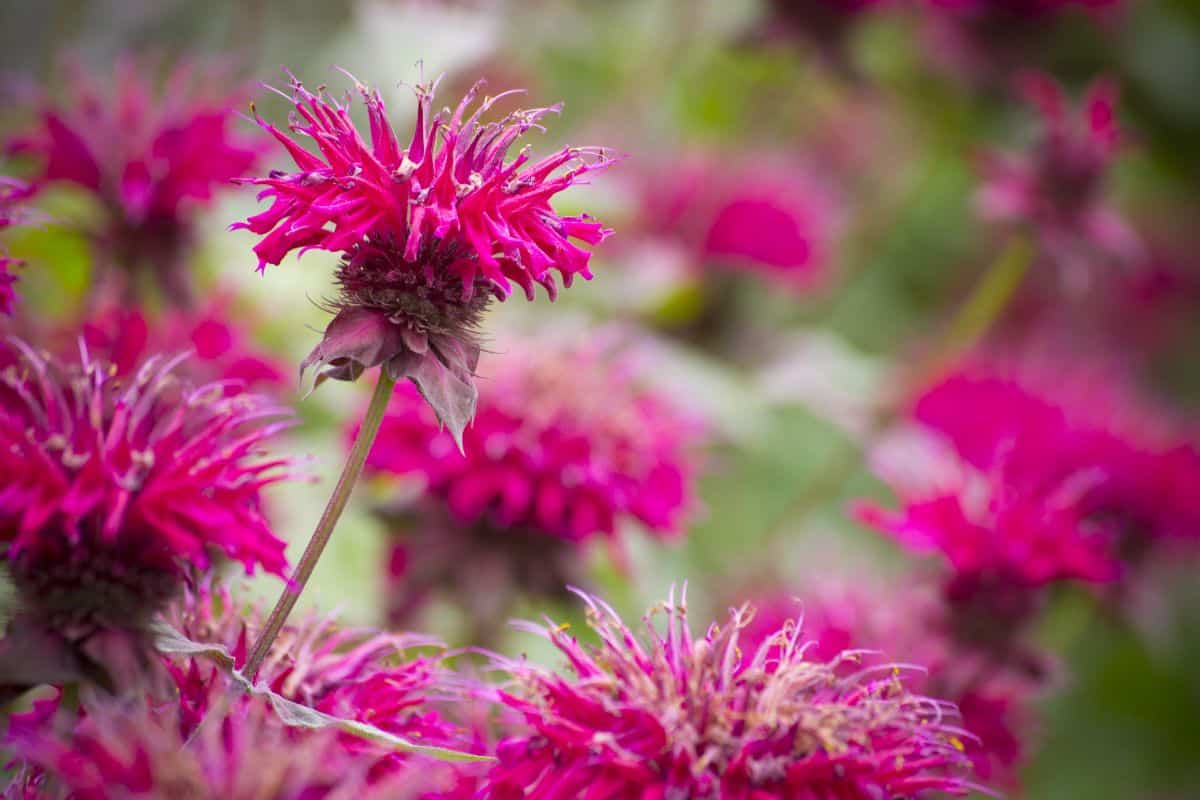
| Plant name: | Bee balm |
| Light requirements: | Full sun |
| Water requirements: | Moderate |
| Growing zone: | Zones 3 to 9 |
| Bloom time: | Summer to early fall |
With a name like a bee balm, you know this plant is going to be great for your beehives! Both honeybees and native bees adore bee balm’s spiky flower heads, and bee balm blooms are often absolutely coated with bees during the peak of summer. Bee balm begins to bloom in summer, and while flowers are usually a bright pink, you can find bee balm with purple, red, and white flowers too.
Standard-sized bee balm plants grow about 4’ tall, but there are also dwarf varieties available that are the perfect size for container growing. Bee balms prefer sunny gardens with well-draining soil, but they’re generally quite easygoing, and they can even tolerate some drought. Like other members of the mint family, bee balms can spread, but they are so attractive most gardeners don’t mind if they do!
6. Asters (Aster spp.)

| Plant name: | Asters |
| Light requirements: | Full sun to part shade |
| Water requirements: | Moderate |
| Growing zone: | Zones 3 to 8 |
| Bloom time: | Late summer to fall |
A fall favorite, asters are one of the last plants to flower in autumn, which makes them an important food source for bees. Depending on where you live, wild asters may already be growing in your garden, but you can find lots of showy aster varieties to plant too. As with other flower types, asters with wide-open flower faces are the easiest for bees to feed from, while asters with double blooms may not provide as many benefits to your bees.
There are about 170 different species of asters and countless other hybrids. Some asters only grow about 1’ tall, and they are perfect for keeping in pots, but you can also find massive, 6’ tall asters that will really draw the eye when grown in a group towards the back of your garden beds. If you want to really light up your fall garden with color, try growing asters with goldenrod!
7. Liatris (Liatris spicata)
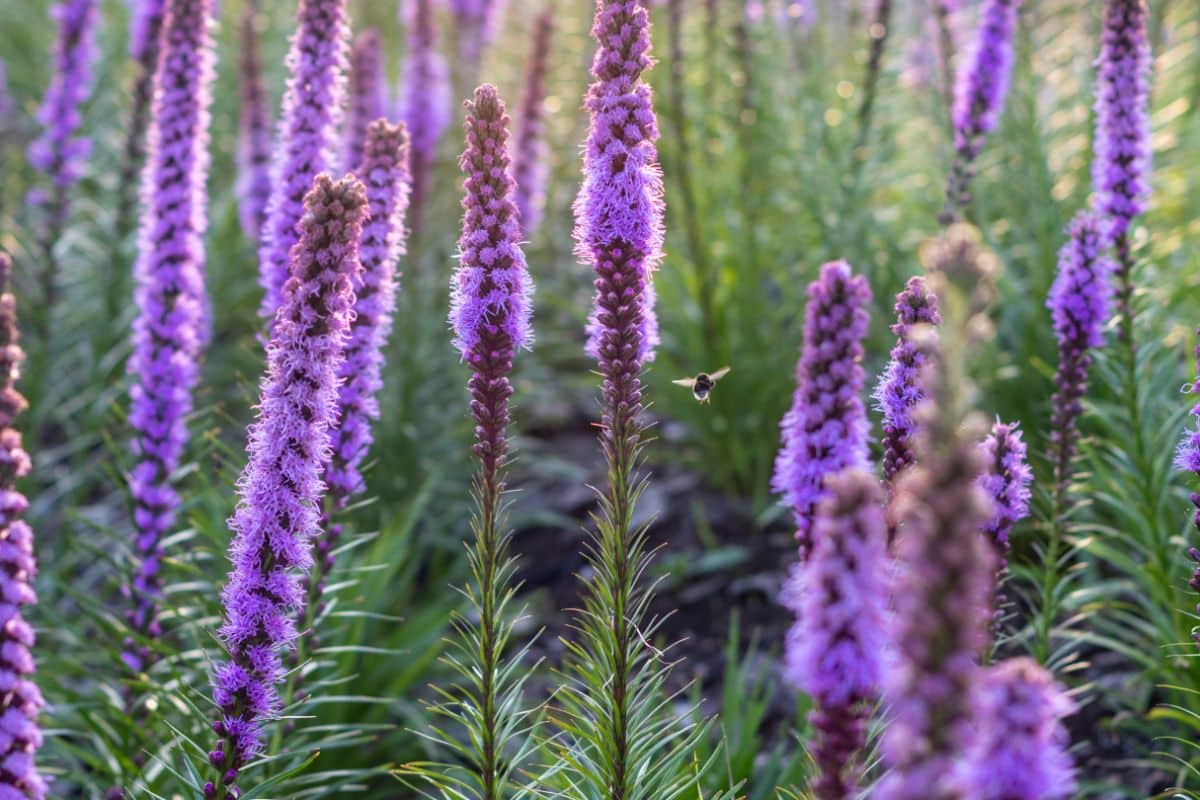
| Plant name: | Liatris |
| Light requirements: | Full sun to part shade |
| Water requirements: | Moderate to low |
| Growing zone: | Zones 3 to 8 |
| Bloom time: | Summer to fall |
Also known as a blazing star or gayfeather, liatris is a member of the aster family; however, liatris has a unique, bottlebrush-shaped flower head that is very striking in mixed flower beds. Most often, liatris flowers are purple to pink in color, but you can also find white varieties as well. These plants also have a mass of slender, grass-like leaves that are quite subtle, but they still add nice texture and movement to flower beds when grown en masse.
Many pollinators, including bees and butterflies, love liatris flowers, and you’ll adore these plants since they are so easygoing. Most often, liatris are grown from nursery starts or corms that are planted in spring after the danger of frost has passed. For a more natural-looking and colorful flower display, try growing at least 3 to 5 liatris plants together.
8. Coriander (Coriandrum sativum)
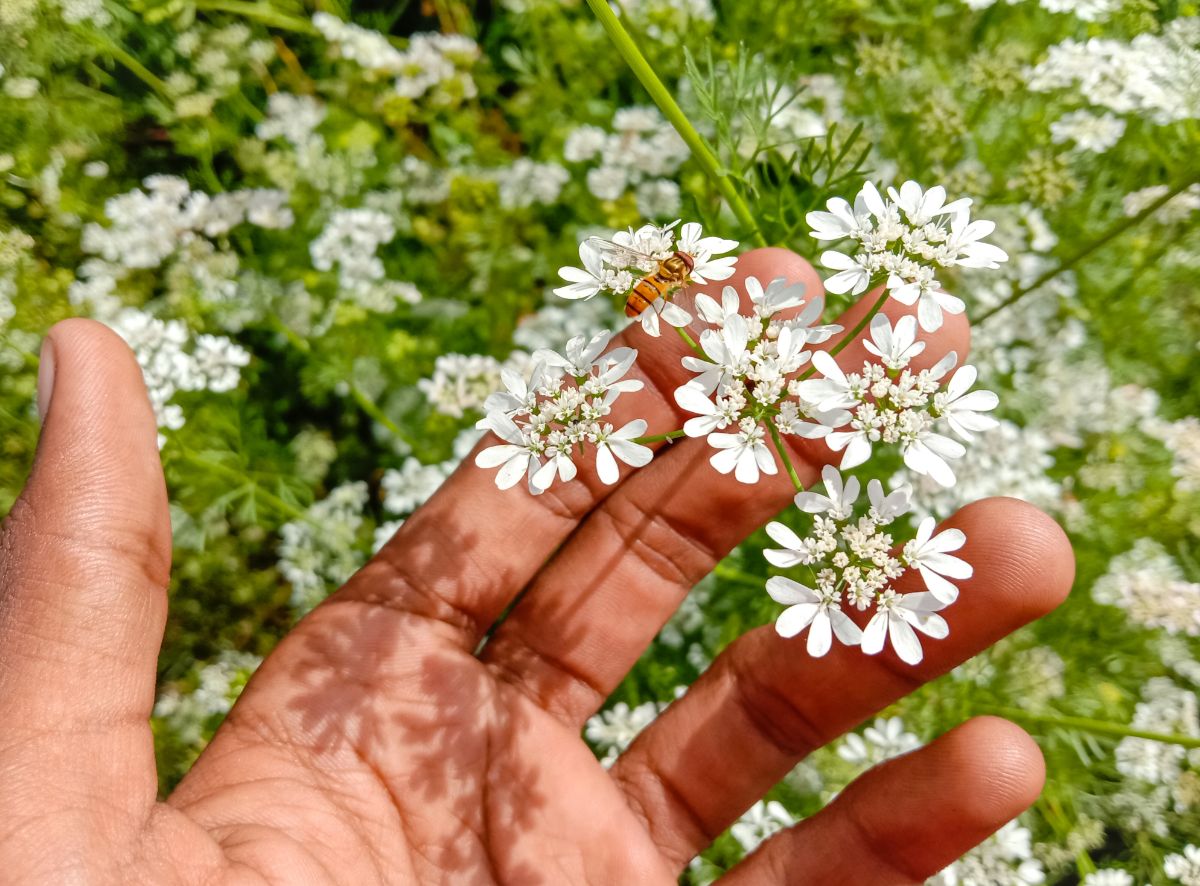
| Plant name: | Coriander |
| Light requirements: | Full sun to part shade |
| Water requirements: | High to moderate |
| Growing zone: | Zones 4 to 10 |
| Bloom time: | Summer |
A popular edible herb, coriander or cilantro, is often overlooked as a pollinator plant, but bees absolutely love foraging from coriander flowers. In fact, coriander honey is a popular honey type that is often sold at boutique grocery stores, and it’s known for having a unique flavor with notes of gingerbread and cardamom.
Coriander is often grown from seed that can be directly sown in garden beds in spring. However, these plants don’t tolerate heat well, and they often bolt in the summer. While this is a problem if you want to harvest cilantro leaves, if you’re growing coriander for bees, you actually want your plants to bolt since that’s when they’ll flower.
9. Cover crops
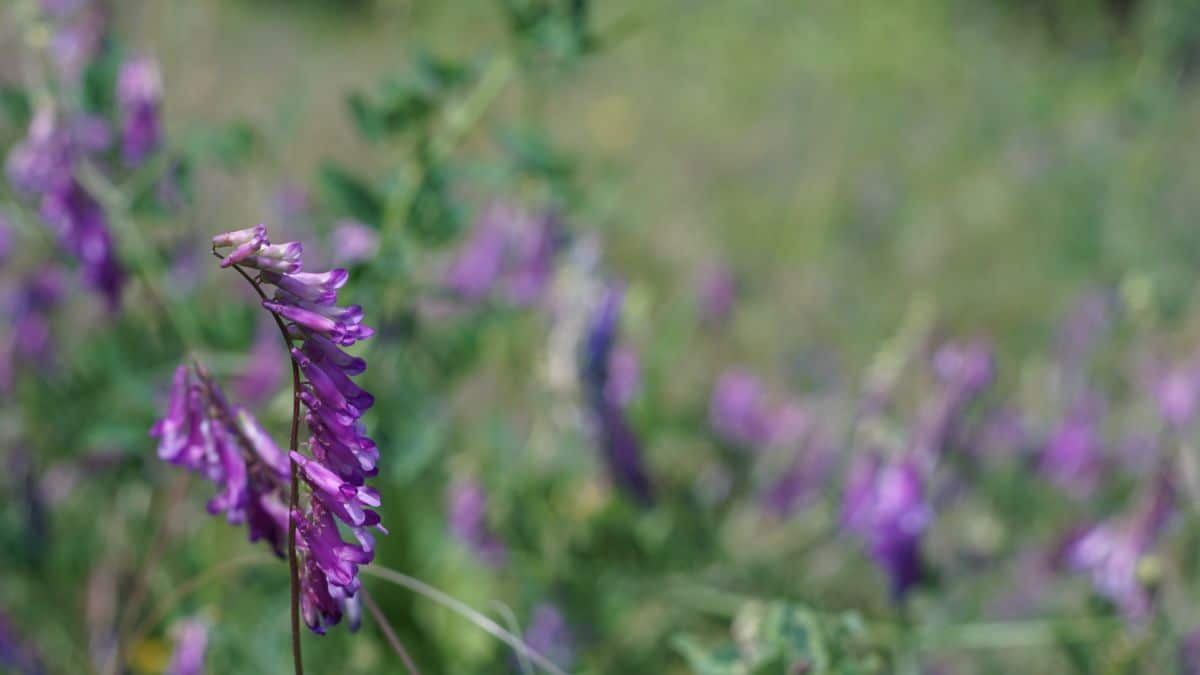
| Plant name: | Cover crops |
| Light requirements: | Depends on variety |
| Water requirements: | Depends on variety |
| Growing zone: | Depends on variety |
| Bloom time: | Depends on variety |
Cover crops are often planted in vegetable gardens towards the end of the season to rejuvenate soil nutrients and keep weeds from sprouting. But cover crops can be grown throughout the spring and summer months on fallow garden beds to improve soil quality or provide an extra food source for nearby honeybee hives.
Not all cover crops will provide a lot of benefits for bees, but flowering cover crops will. Some of the best choices of cover crops for honey production are vetch, field peas, and various types of clover.
10. Dandelions (Taraxacum officinale)
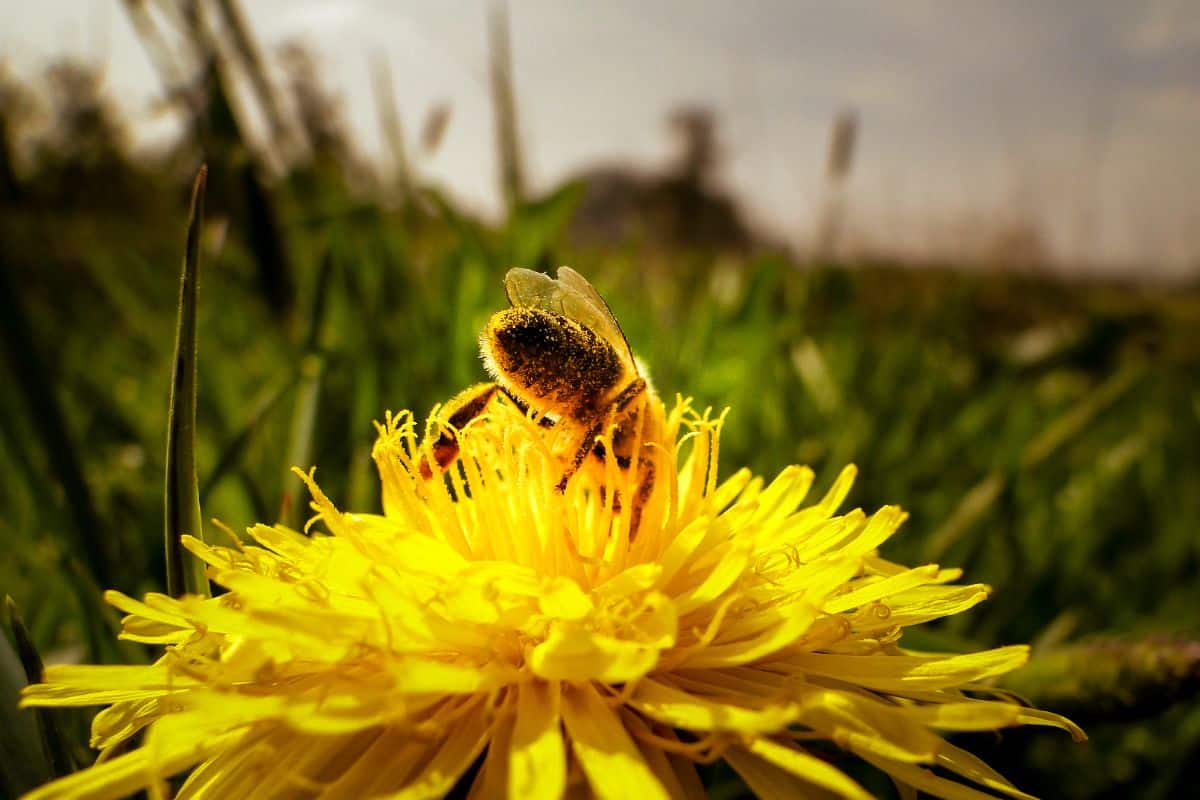
| Plant name: | Dandelions |
| Light requirements: | Full sun to part shade |
| Water requirements: | Moderate |
| Growing zone: | Zones 3 to 9 |
| Bloom time: | Spring to fall |
Many people consider dandelions to be nuisance weeds, but they provide a lot of food for insects, including honeybees! Dandelion flowers are full of nectar and honey, and they also bloom earlier in the season than many other plants. So, if you want to provide a reliable food source for your hives in spring, allow some dandelions to grow in your garden!
While dandelions often crop up on their own, if you love the thought of growing dandelions intentionally, you can purchase French dandelion seeds, which are often grown for their greens. You can also find adorable pink dandelions that will add a lovely pop of color to yards, ornamental beds, and window boxes.
11. Cosmos (Cosmos spp.)
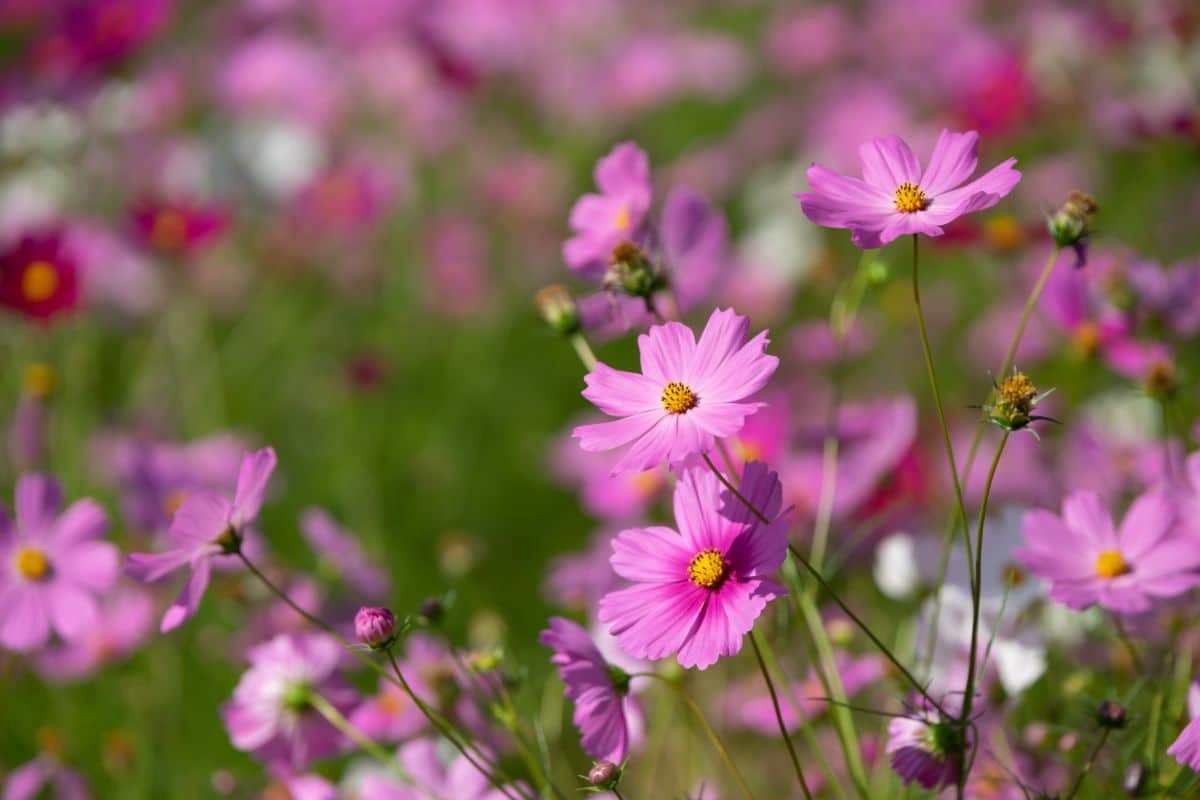
| Plant name: | Cosmos |
| Light requirements: | Full sun to part shade |
| Water requirements: | Moderate to low |
| Growing zone: | Zones 2 to 11 |
| Bloom time: | Summer to fall |
Cosmos are low-maintenance, annual plants that are often kept in ornamental beds and cutting gardens. But a patch of cosmos planted around your beehives will add lots of charm and color. Plus, cosmos’ wide open flower heads will also provide a lot of nectar and pollen for your bees too.
Cosmos flowers come in white and various shades of pink, and these plants also have pretty, feathery foliage that catches the wind beautifully. Most often, cosmos are grown from seeds, and they grow so quickly that you’ll get boatloads of flowers about 3 months after planting. But, if you want flowers even earlier, you can also raise cosmos from organically grown nursery starts.
12. Mint (Lamiaceae spp.)
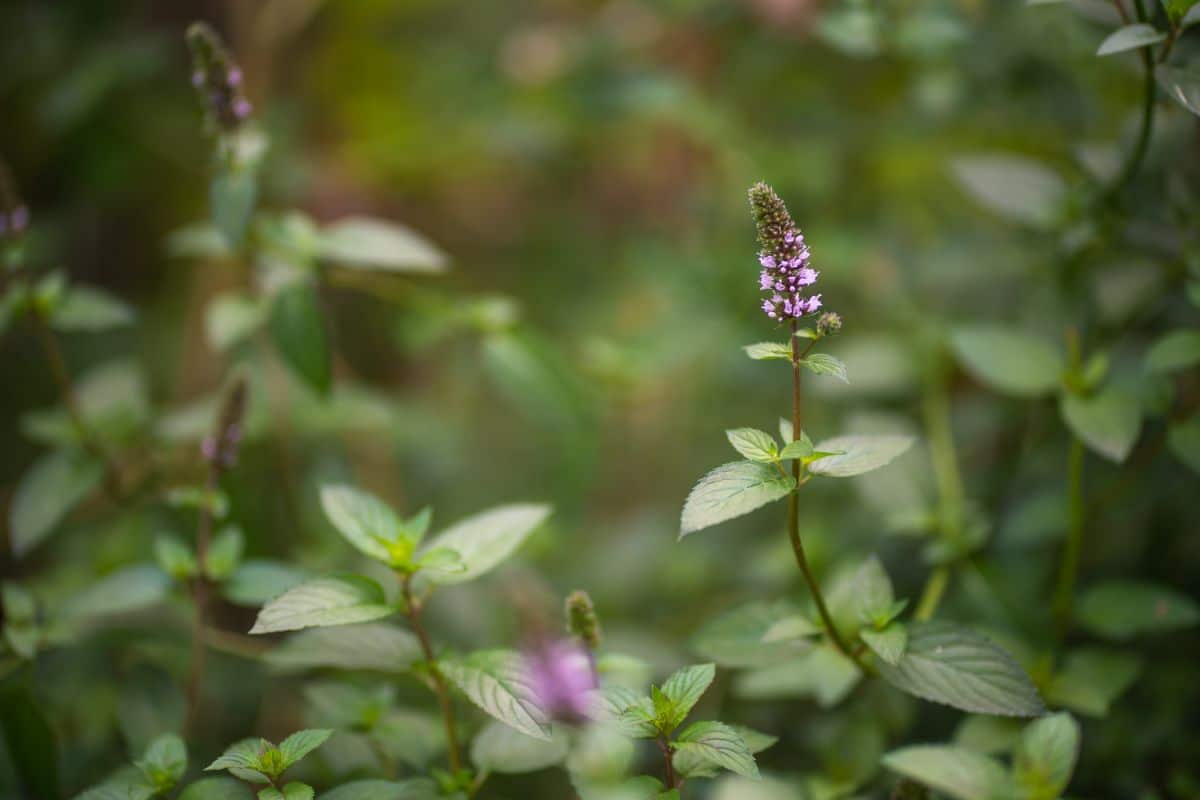
| Plant name: | Mint |
| Light requirements: | Full sun to part shade |
| Water requirements: | High to moderate |
| Growing zone: | Zones 3 to 8 |
| Bloom time: | Summer to fall |
Mint plants are rather notorious for their vigorous growing habit, and they can become invasive in some areas. However, mint’s easygoing nature makes it super low maintenance to keep, and if you grow these plants in pots near your hives, you won’t need to worry about them taking over. That said, mints can be kept as flowering groundcovers, too, and swapping out some of your turf grass lawn for mint can make your backyard even more bee-friendly!
While you’re probably most familiar with peppermint and spearmint, there are a lot of other plants in the mint family that bees love. Plants like lemon balm, catnip, and mountain mint are all good choices for planting near beehives!
13. Goldenrod (Solidago spp.)
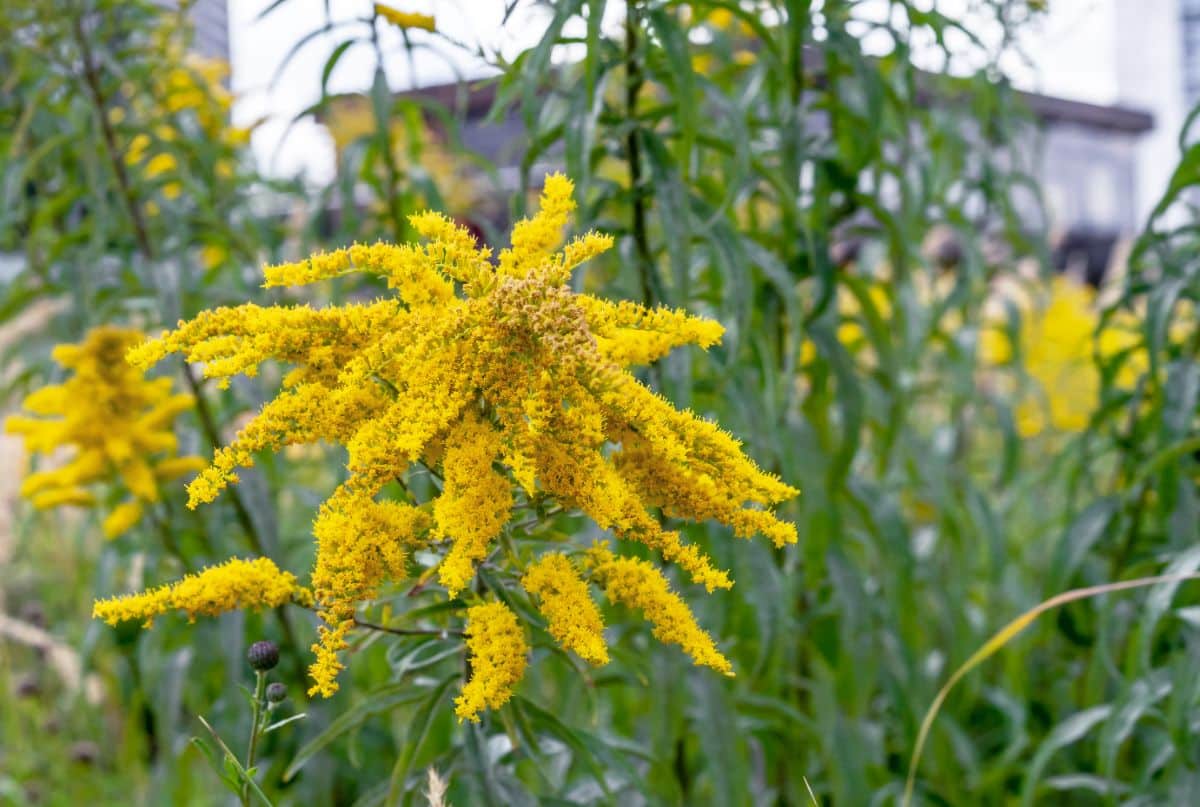
| Plant name: | Goldenrod |
| Light requirements: | Full sun to part shade |
| Water requirements: | Moderate to low |
| Growing zone: | Zones 2 to 8 |
| Bloom time: | Late summer to fall |
Goldenrod’s rich, yellow color looks spectacular when grown beside the brilliant purples of asters and coneflowers. That’s why these plants are often the stars of fall gardens. But if you keep bees, goldenrod is an exceptional plant to grow because it will often flower right up until frost arrives!
Some gardeners resist planting goldenrod because they associate it with seasonal allergies. However, it’s actually the similar-looking ragweed plant that is mostly responsible for itchy eyes and sneezing. Goldenrod, on the other hand, is an attractive ornamental that can also be used for cut flowers or homemade dye making!
14. Coneflower (Echinacea spp.)
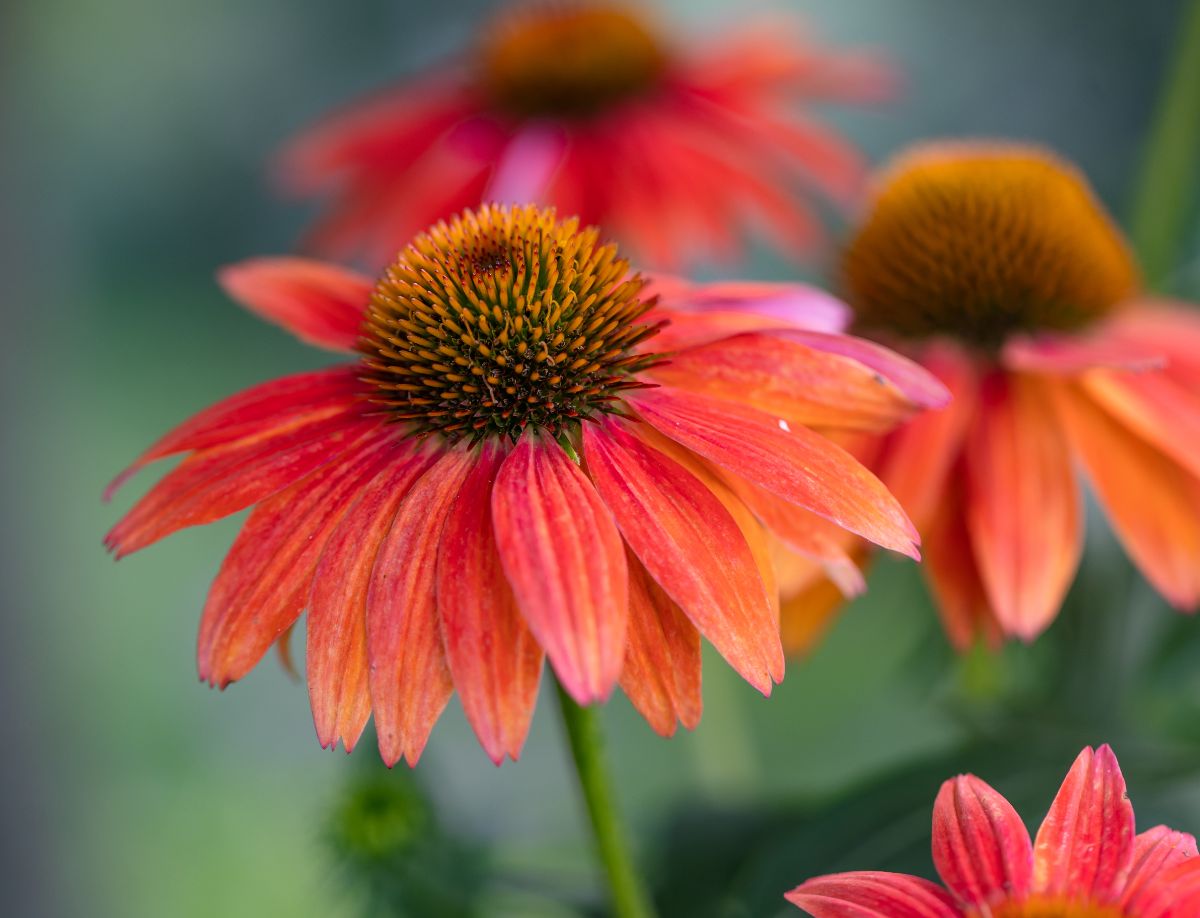
| Plant name: | Coneflower |
| Light requirements: | Full sun |
| Water requirements: | Moderate to low |
| Growing zone: | Zones 3 to 9 |
| Bloom time: | Mid-summer to fall |
Another late-season bloomer, coneflowers often have purple petals, but you can find coneflower varieties with red, orange, white, pink, and yellow blooms. A hardy plant, coneflowers can grow in many different gardens, and they can also tolerate drought. In ornamental beds, coneflowers look enchanting when planted together in a large group, but they also pair beautifully with many other bee favorites, like Russian sage, milkweed, and liatris.
Beyond being great plants for bees, coneflowers can also be used for cut flowers, and their seeds are a hit with birds in the fall and winter. You can also save coneflower seeds and start your own plants indoors in spring, but seeds will germinate better if you cold-stratify them before planting.
15. White Dutch clover (Trifolium repens)
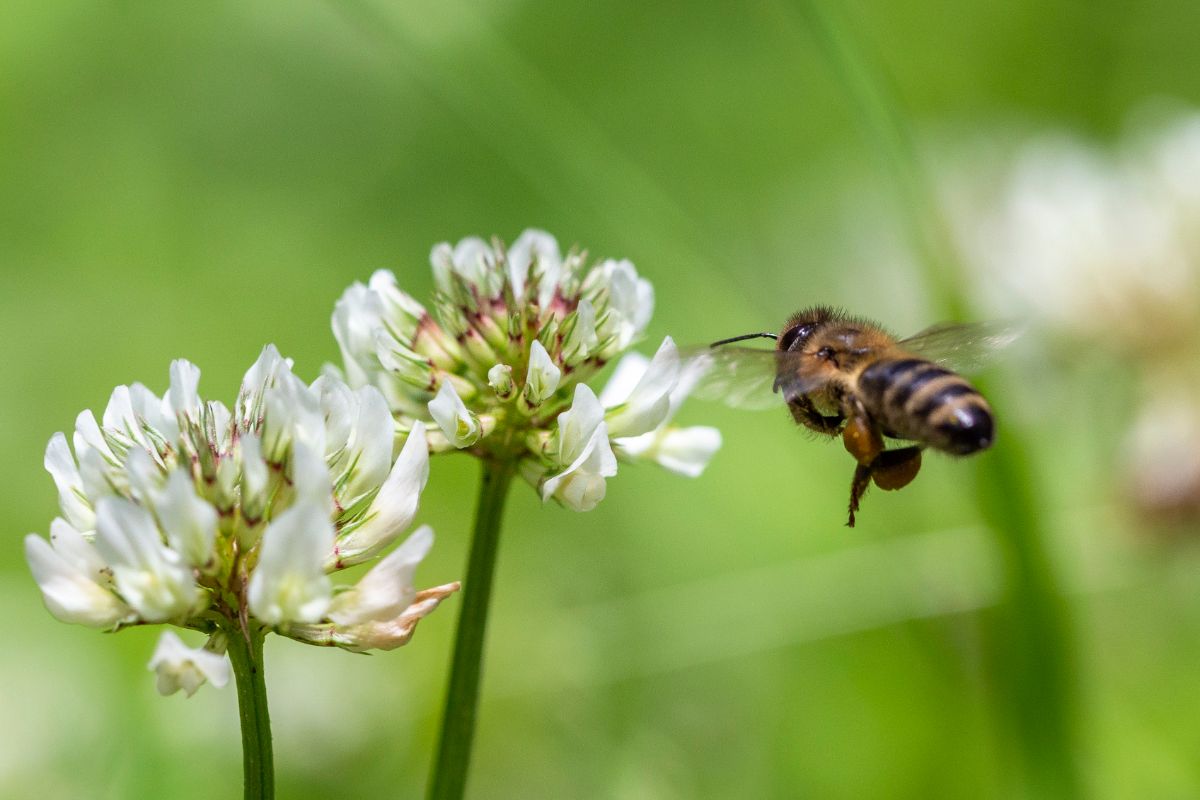
| Plant name: | White Dutch clover |
| Light requirements: | Full sun to part shade |
| Water requirements: | Low |
| Growing zone: | Zones 4 to 9 |
| Bloom time: | Spring to summer |
Turf grass lawns won’t do bees any good, and they can require a lot of water to keep them looking green. That’s why so many beekeepers are switching over to clover lawns, which are an eco-friendly grass alternative that will save you time, money, and water too. And, as a big bonus, clover lawns also produce a lot of nectar and pollen to fuel your honey-making beehives!
Depending on how much work you want to devote to your lawn, you can convert your entire lawn to clover, or you can just overseed an existing lawn with clover and allow it to sprout in patches. An added benefit of clover lawns is that they require less mowing, and the less you mow them, the more flowers they’ll produce for your bees.
16. Berries
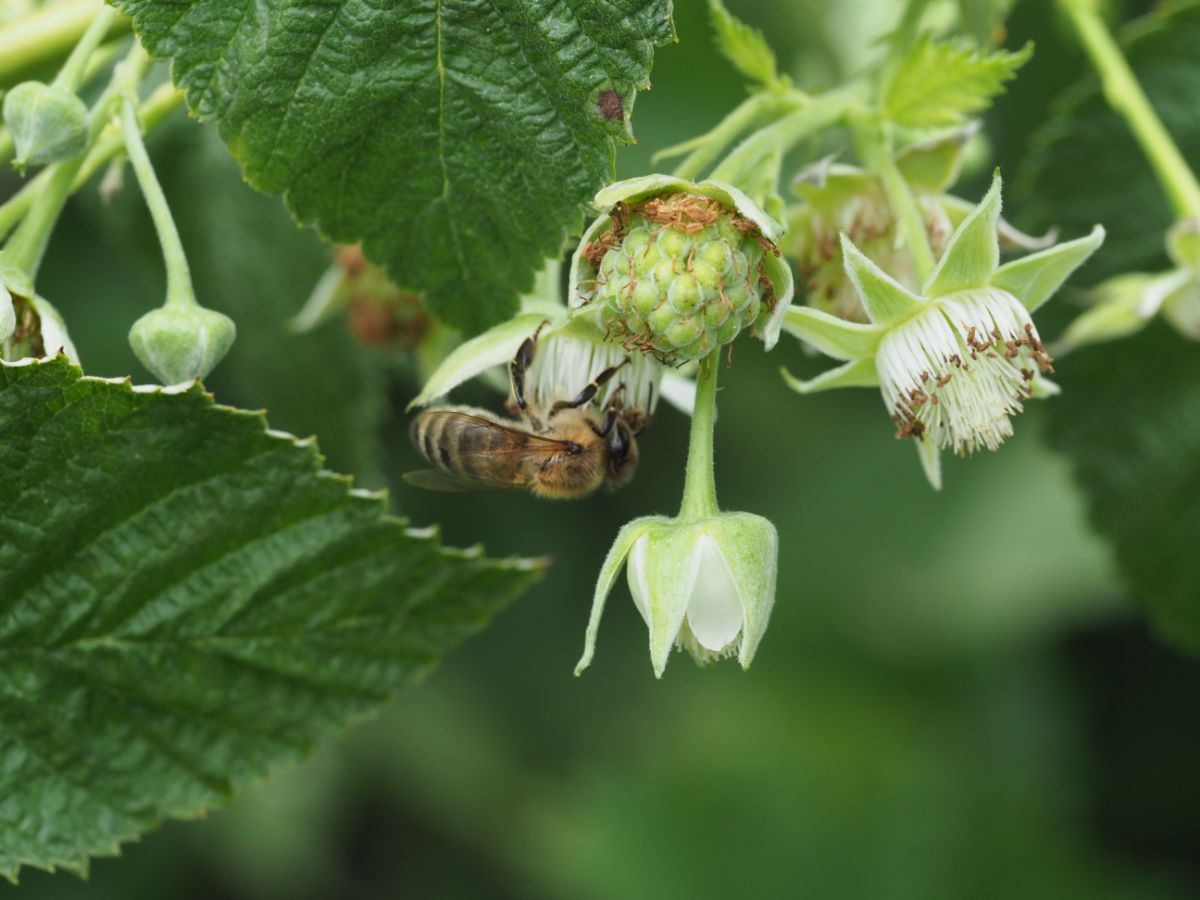
| Plant name: | Berries |
| Light requirements: | Full sun |
| Water requirements: | Moderate |
| Growing zone: | Depends on variety |
| Bloom time: | Spring to summer |
If you’ve ever grown raspberries, blackberries, strawberries, and other berry plants, you’ve probably noticed that bees can’t get enough of their flowers. Berry flowers are often covered with bees during the peak of summer, but berries usually flower early in the season, and they can provide an important source of nectar for bees in spring before other plants emerge.
Depending on your garden, you can grow a wide variety of berry plants for your beehives. Strawberries are particularly small space friendly, and they can even be grown in hanging baskets on a back porch or patio. Plus, if you grow berry plants near your hives, you’ll be able to gather the ingredients for a scrumptious strawberry shortcake with a drizzle of homegrown honey on top!
17. Fruit trees
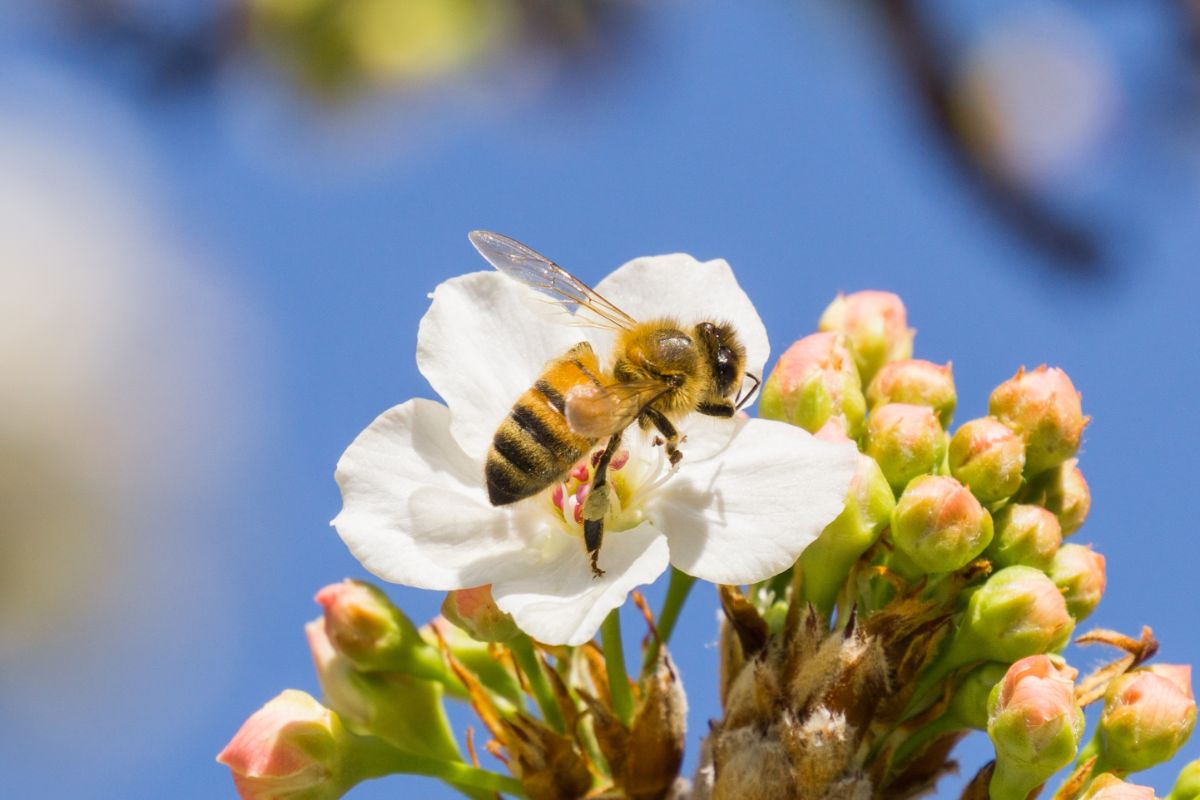
| Plant name: | Fruit trees |
| Light requirements: | Full sun |
| Water requirements: | Moderate |
| Growing zone: | Depends on variety |
| Bloom time: | Early spring to late summer |
From apples to pears and cherries, there are many different fruit plants that can be grown in a small garden or backyard orchard. Like berry plants, fruit trees usually flower in spring, and they will provide lots of nectar and pollen for your bees. And, even if you don’t want to grow fruit, ornamental trees, like flowering cherries, are also irresistible to bees.
Beehives nestled beneath fruit trees can look quite picturesque, but this setup will also provide some dappled shade to your beehives during the heat of summer. Bees may also feast upon overly ripe fruit, but if they make it difficult to harvest your crops, you may want to add some fruit protection bags to your trees.
18. Cucurbits
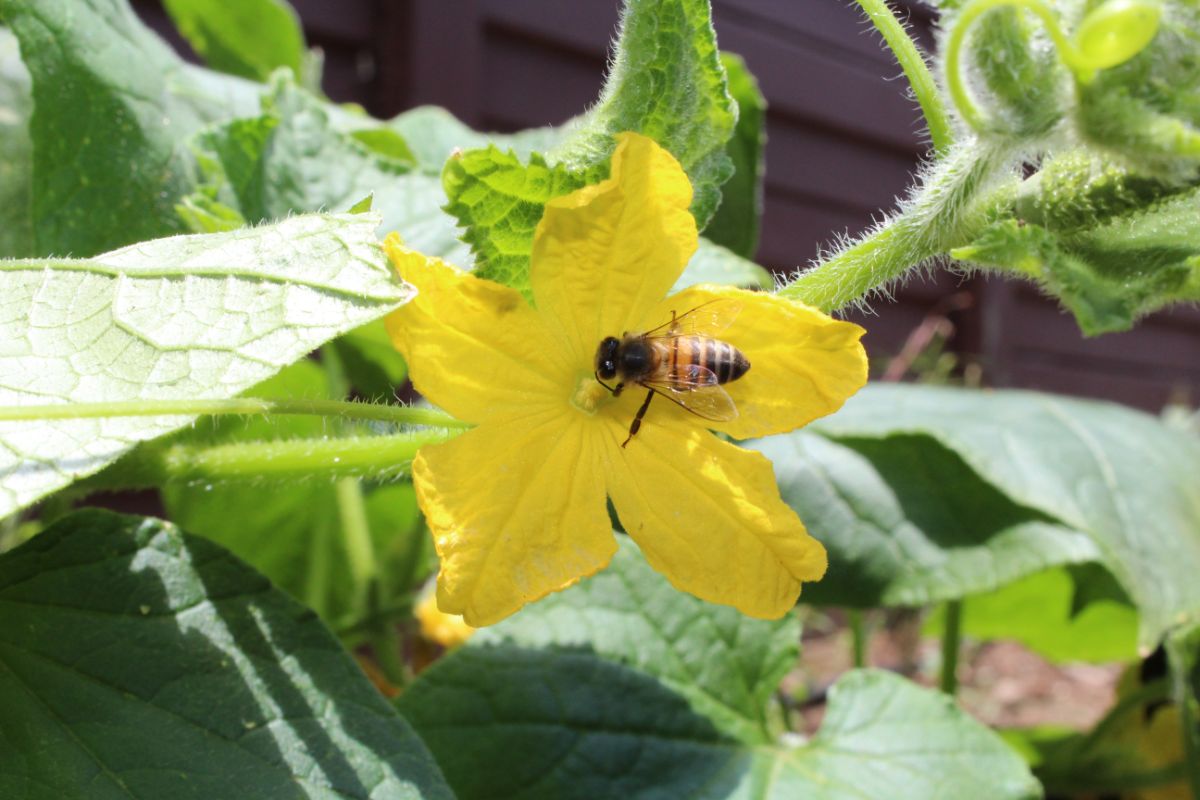
| Plant name: | Cucurbits |
| Light requirements: | Full sun |
| Water requirements: | Moderate |
| Growing zone: | Depends on variety |
| Bloom time: | Spring to summer |
Many vegetable gardeners struggle with low harvest yields from plants in the cucurbit family, including squash, melons, cucumbers, pumpkins, zucchini, and gourds. Often, this has to do with low pollination rates, which result in flowers that never mature into fruit! However, if you happen to keep bees, you can boost the yields from your vegetable patch and help your bees out at the same time by moving your hives near your cucurbit plants.
Bees are excellent pollinators of cucurbits, and you’ll likely see an immediate boost in your melon and pumpkin harvests from the work of your bees. In return, your bees will find ample food in squash and cucumber blossoms!
Summary
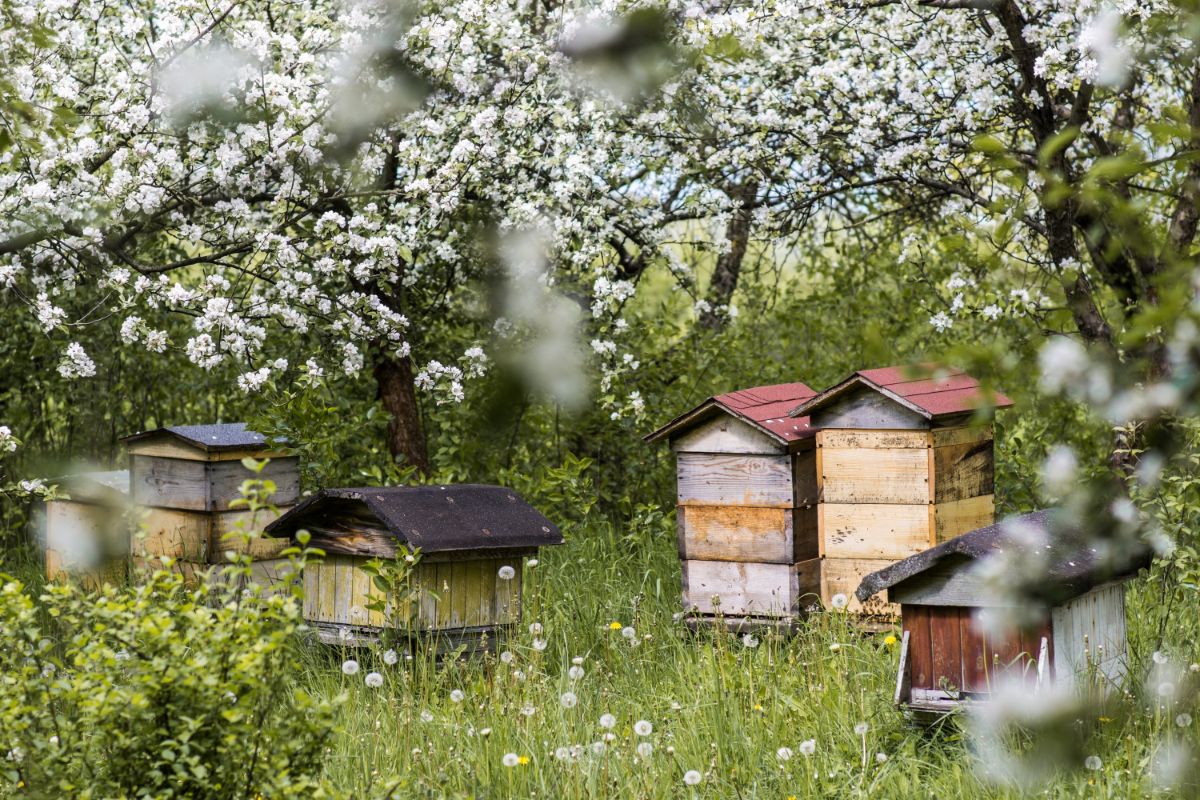
Keeping your own beehives for homegrown honey can be an exciting experiment and a wonderful learning opportunity. As you get more comfortable working with bees, you can curate the plants closest to your beehives to see how different plants influence the flavor of your honey. Or you can grow a medley of plants and give your bees an assortment of flowers to choose from.
While ornamental and vegetable plants can provide a lot of resources for honeybees, some of the best plants to grow near your hives are wildflowers and native plants. So if you happen to have some native plant volunteers growing near your bee setup, consider allowing them to grow right where they are. Your bees will probably love them too!
Beyond growing the right plants for bees, if you want to keep beehives in your garden, it’s also a good idea to include other pollinator garden elements in your space to boost bee activity and health. You can learn more about gardening for bees with this simple guide on creating a pollinator habitat.

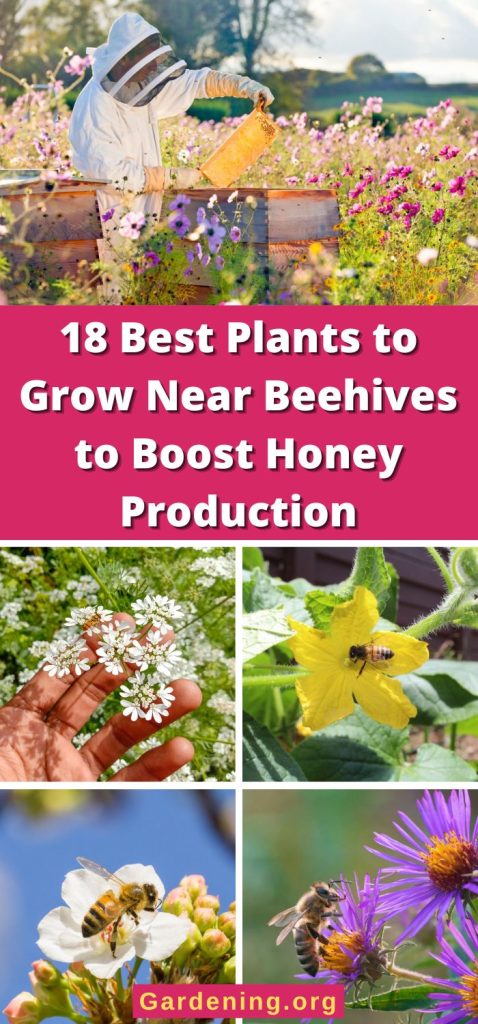
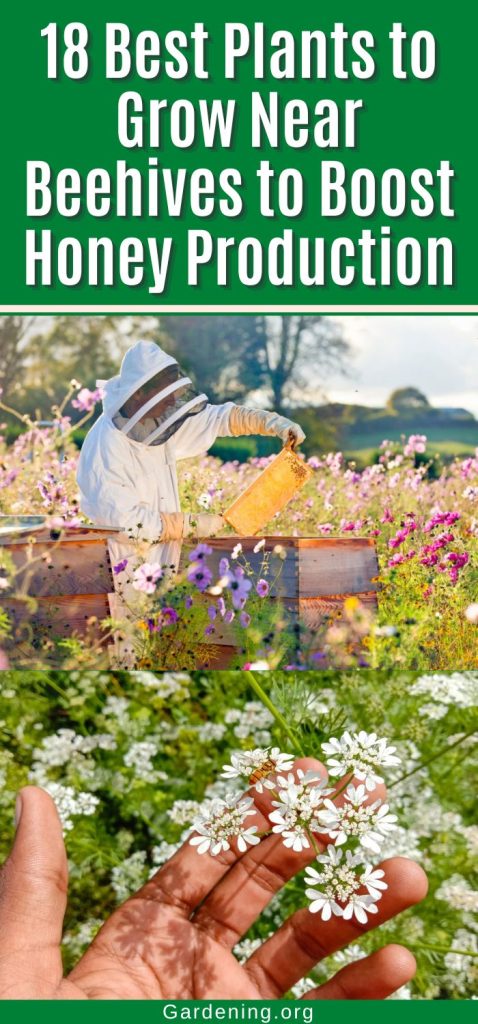
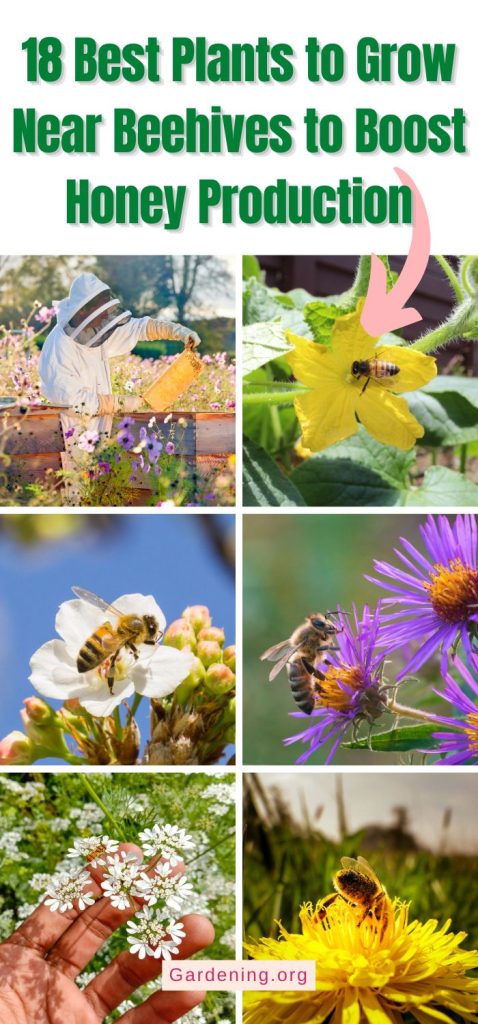
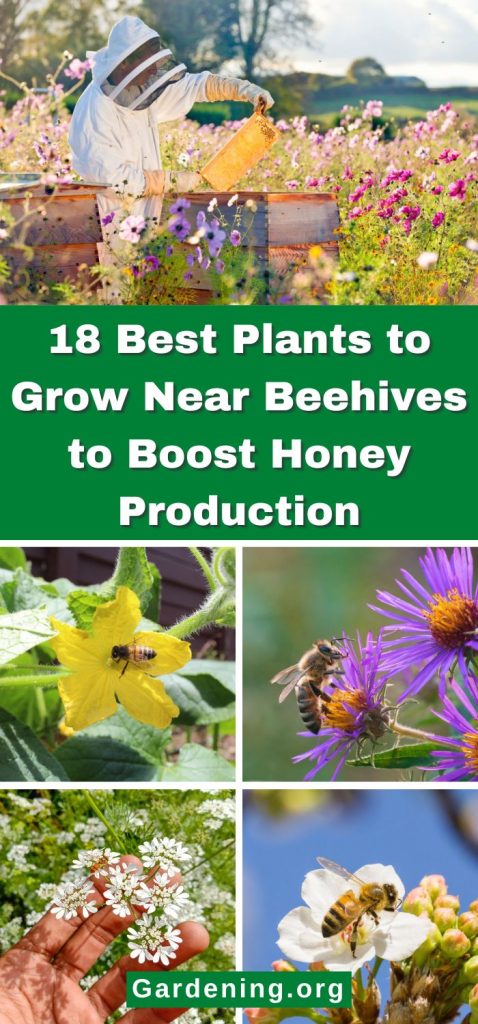

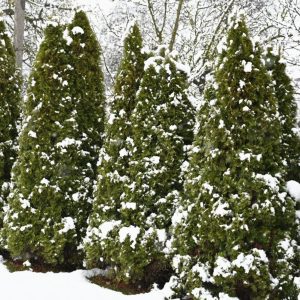


Jo Whyatt
My Passion flowers are always covered with bees I do have some of the plants on your list but my Passion flower tops all the rest
.